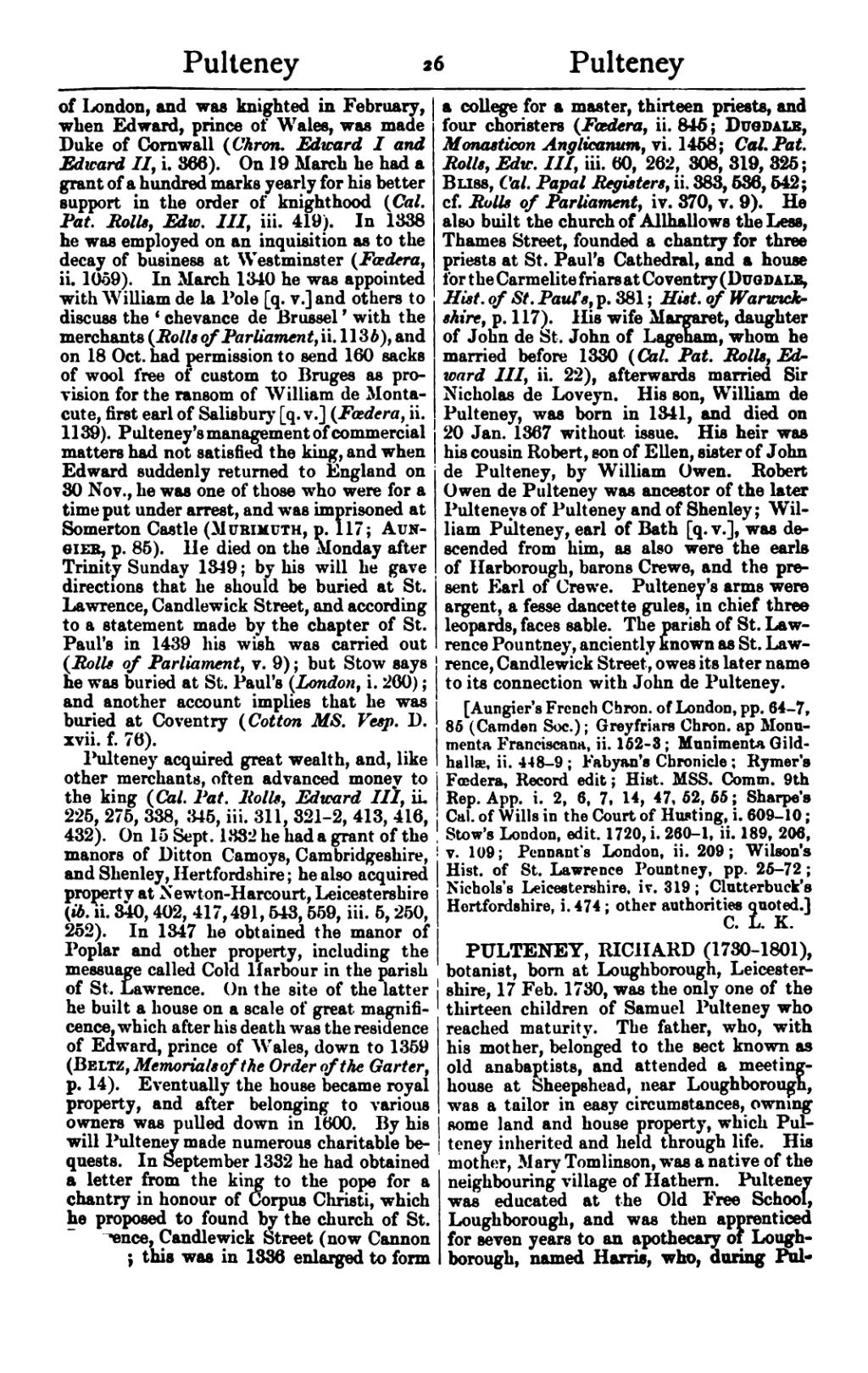of London, and was knighted in February, when Edward, prince of Wales, was made Duke of Cornwall (Chron. Edward I and Edward II, i. 366). On 19 March he had a grant of a hundred marks yearly for his better support in the order of knighthood (Cal. Pat. Rolls, Edw. III, iii. 419). In 1338 he was employed on an inquisition as to the decay of business at Westminster (Fœdera, ii. 1059). In March 1340 he was appointed with William de la Pole [q. v.] and others to discuss the ‘chevance de Brussel’ with the merchants (Rolls of Parliament, ii. 113 b), and on 18 Oct. had permission to send 160 sacks of wool free of custom to Bruges as provision for the ransom of William de Montacute, first earl of Salisbury [q. v.] (Fœdera, ii. 1139). Pulteney's management of commercial matters had not satisfied the king, and when Edward suddenly returned to England on 30 Nov., he was one of those who were for a time put under arrest, and was imprisoned at Somerton Castle (Murimuth, p. 117; Aungier, p. 85). He died on the Monday after Trinity Sunday 1349; by his will he gave directions that he should be buried at St. Lawrence, Candlewick Street, and according to a statement made by the chapter of St. Paul's in 1439 his wish was carried out (Rolls of Parliament, v. 9); but Stow says he was buried at St. Paul's (London, i. 260); and another account implies that he was buried at Coventry (Cotton MS. Vesp. D. xvii. f. 76).
Pulteney acquired great wealth, and, like other merchants, often advanced money to the king (Cal. Pat. Rolls, Edward III, ii. 225, 275, 338, 345, iii. 311, 321–2, 413, 416, 432). On 15 Sept. 1332 he had a grant of the manors of Ditton Camoys, Cambridgeshire, and Shenley, Hertfordshire; he also acquired property at Newton-Harcourt, Leicestershire (ib. ii. 340, 402, 417, 491, 543, 559, iii. 5, 250, 252). In 1347 he obtained the manor of Poplar and other property, including the messuage called Cold Harbour in the parish of St. Lawrence. On the site of the latter he built a house on a scale of great magnificence, which after his death was the residence of Edward, prince of Wales, down to 1359 (Beltz, Memorials of the Order of the Garter, p. 14). Eventually the house became royal property, and after belonging to various owners was pulled down in 1600. By his will Pulteney made numerous charitable bequests. In September 1332 he had obtained a letter from the king to the pope for a chantry in honour of Corpus Christi, which he proposed to found by the church of St. Lawrence, Candlewick Street (now Cannon Street); this was in 1336 enlarged to form a college for a master, thirteen priests, and four choristers (Fœdera, ii. 845; Dugdale, Monasticon Anglicanum, vi. 1458; Cal. Pat. Rolls, Edw. III, iii. 60, 262, 308, 319, 325; Bliss, Cal. Papal Registers, ii. 383, 536, 542; cf. Rolls of Parliament, iv. 370, v. 9). He also built the church of Allhallows the Less, Thames Street, founded a chantry for three priests at St. Paul's Cathedral, and a house for the Carmelite friars at Coventry (Dugdale, Hist. of St. Paul's, p. 381; Hist. of Warwickshire, p. 117). His wife Margaret, daughter of John de St. John of Lageham, whom he married before 1330 (Cal. Pat. Rolls, Edward III, ii. 22), afterwards married Sir Nicholas de Loveyn. His son, William de Pulteney, was born in 1341, and died on 20 Jan. 1367 without issue. His heir was his cousin Robert, son of Ellen, sister of John de Pulteney, by William Owen. Robert Owen de Pulteney was ancestor of the later Pulteneys of Pulteney and of Shenley; William Pulteney, earl of Bath [q. v.], was descended from him, as also were the earls of Harborough, barons Crewe, and the present Earl of Crewe. Pulteney's arms were argent, a fesse dancette gules, in chief three leopards' faces sable. The parish of St. Lawrence Pountney, anciently known as St. Lawrence, Candlewick Street, owes its later name to its connection with John de Pulteney.
[Aungier's French Chron. of London, pp. 64–7, 85 (Camden Soc.); Greyfriars Chron. ap Monumenta Franciscana, ii. 152–3; Munimenta Gildhallæ, ii. 448–9; Fabyan's Chronicle; Rymer's Fœdera, Record edit.; Hist. MSS. Comm. 9th Rep. App. i. 2, 6, 7, 14, 47, 52, 55; Sharpe's Cal. of Wills in the Court of Husting, i. 609–10; Stow's London, edit. 1720, i. 260–1, ii. 189, 206, v. 109; Pennant's London, ii. 209; Wilson's Hist. of St. Lawrence Pountney, pp. 25–72; Nichols's Leicestershire, iv. 319; Clutterbuck's Hertfordshire, i. 474; other authorities quoted.]
PULTENEY, RICHARD (1730–1801), botanist, born at Loughborough, Leicestershire, 17 Feb. 1730, was the only one of the thirteen children of Samuel Pulteney who reached maturity. The father, who, with his mother, belonged to the sect known as old anabaptists, and attended a meeting-house at Sheepshead, near Loughborough, was a tailor in easy circumstances, owning some land and house property, which Pulteney inherited and held through life. His mother, Mary Tomlinson, was a native of the neighbouring village of Hathern. Pulteney was educated at the Old Free School, Loughborough, and was then apprenticed for seven years to an apothecary of Loughborough, named Harris, who, during Pul-
